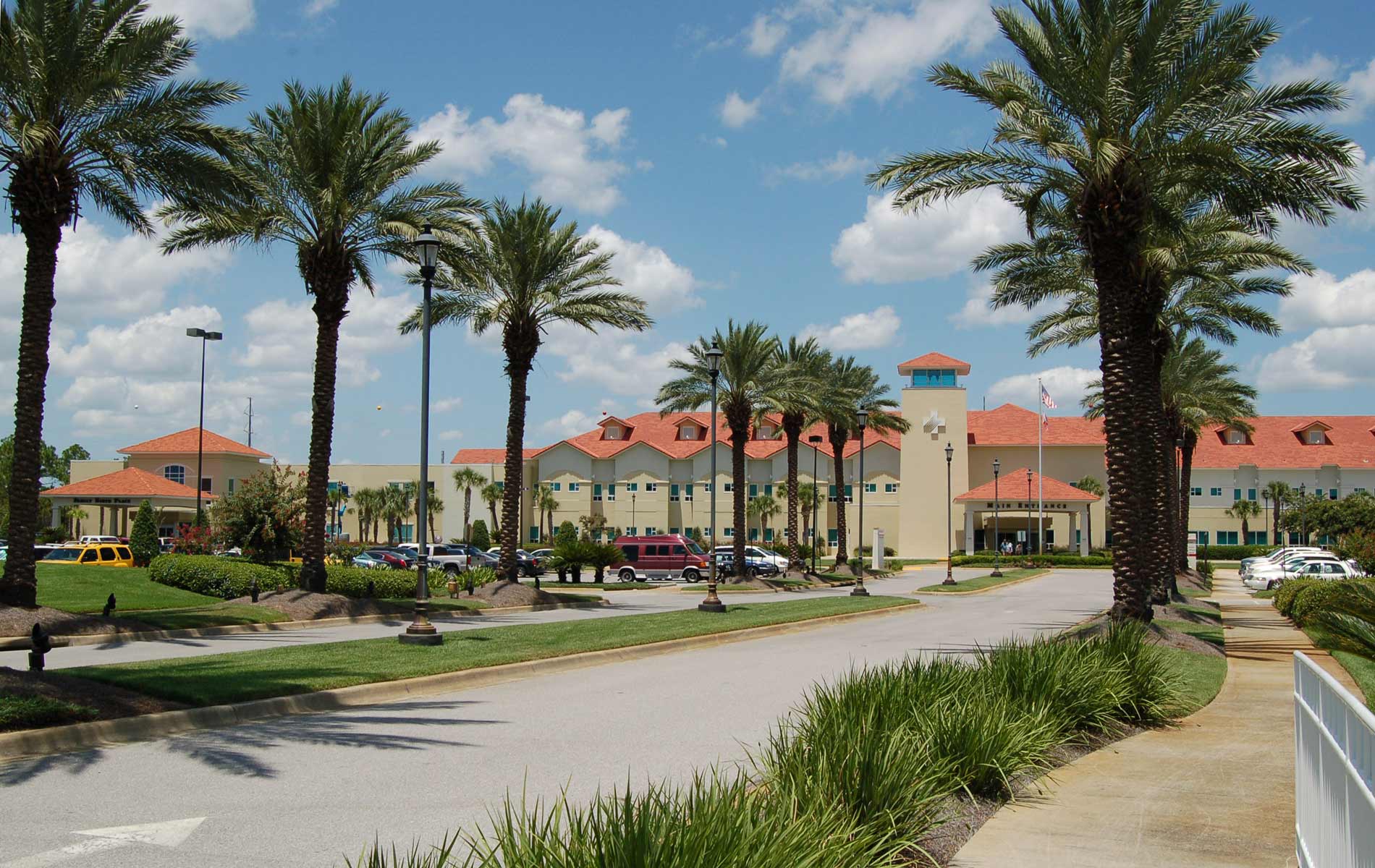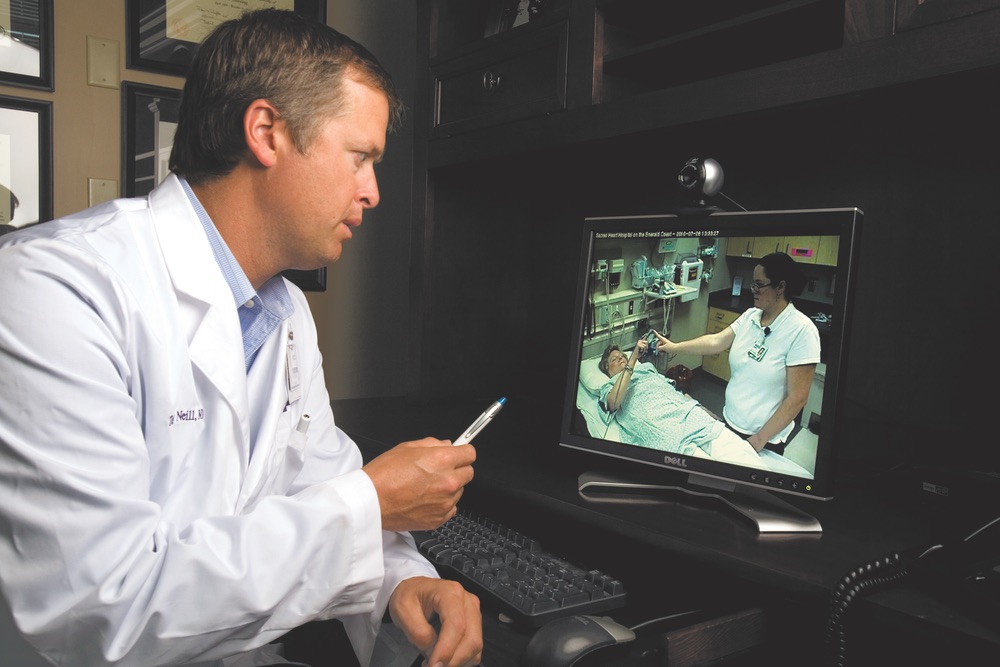
vie-magazine-sacred-heart-feature
Open or Shut Case
By Stephanie Clay
It was a defining moment. In 1959, the Daughters of Charity sent Sister Frances Michael from the provincial motherhouse in Emmitsburg, Maryland, to Pensacola, Florida, to decide the fate of Sacred Heart Hospital.
The Sisters’ vow to serve the region’s sick, poor, and vulnerable had been faithfully fulfilled since they built and opened the majestic, castlelike hospital in 1915. But, by the late 1950s, the 145-bed hospital on Twelfth Avenue had a difficult time keeping up with Pensacola’s burgeoning population. The hospital building, while still magnificent on the outside, was antiquated and deteriorating inside.
Mindful of the burdensome cost of upgrading and expanding the outmoded and overcrowded hospital, the Daughters considered leaving their ministry at Sacred Heart Hospital.
But after arriving in Pensacola, Sr. Frances Michael, the new hospital administrator, became convinced that the people of Pensacola wanted the Sisters and Sacred Heart to stay. She made an appeal to the Daughters of Charity and rallied support from the community to build a bigger, better hospital with modern facilities.

The Daughters of Charity opened the Pensacola Hospital School of Nursing in 1915 and trained approximately 750 new nurses throughout the next fifty-two years.
As Sr. Frances Michael and the visionary Sisters sought out a location for a new hospital, business leaders encouraged them to consider property on the far northern outskirts of the city. Many of the citizens and physicians asked the Sisters, “Who would come to a hospital way out in the woods off of a terrible clay dirt road?”
The Sisters gathered on the land, located on a hill past the end of the pavement on Ninth Avenue, and prayed to ask God if this was where the new hospital should be built. Satisfied they had received their answer, the enterprising Sisters baked homemade raisin bread to help sweeten the negotiations with the owner of the land.
The new hospital was built on that secluded hill, and in 1965, the Sisters and staff of Sacred Heart left the original hospital behind and moved to the new one.

The original Pensacola Hospital (later renamed Sacred Heart) was built and opened on 12th Avenue by the Daughters of Charity in 1915.
At the Heart of Pensacola … and Beyond
Today, Sacred Heart Hospital is at the heart of central Pensacola. The beautifully landscaped hospital campus encompasses the better part of a city block at the busy intersection of Ninth Avenue and Bayou Boulevard, across the street from a popular shopping mall. The “new” hospital built by the Sisters has now become the command center for a regional health system with facilities spanning Northwest Florida and Southern Alabama.
Sacred Heart Health System honors its rich history and the sacred trust the Daughters of Charity have placed in its leaders and associates. They continue the Sisters’ mission of serving all persons, with special attention to the poor and vulnerable. The Health System as a whole provides approximately $16 million per year in charity care and $122 million in uncompensated care charges per year.
The Health System is now part of Ascension Health, the nation’s largest system of not-for-profit health care facilities, and has a regional presence, with hospitals in Pensacola, Miramar Beach and Port St. Joe, Fla. A regional network of more than seven hundred primary care and specialty doctors reaches from Foley, Ala., to Panama City Beach, Fla.

Sacred Heart Hospital in Pensacola is the main campus for the Health System
Sacred Heart also supports training of medical students and operates residency programs in pediatrics and OB/GYN in affiliation with the Florida State University College of Medicine. Student nurses from several local universities also receive training at the hospital.
Sacred Heart’s 466-bed acute care hospital in Pensacola is consistently chosen by consumers as the most preferred hospital in Northwest Florida in a survey by National Research Corporation. It also is ranked in the top 5 percent of the nation’s hospitals for clinical excellence in 2011 by HealthGrades, a leading independent health care ratings firm.
The Pensacola campus offers the only women’s and children’s hospitals in the region; Children’s Hospital operates in partnership with Nemours Children’s Clinic. Other key services based in Pensacola include the Regional Heart and Vascular Institute; the Regional Stroke Center; the Trauma Center (a Level II facility); and the Cancer Center, which is affiliated with MD Anderson Physicians Network.
Other key services based in Pensacola include the Regional Heart and Vascular Institute; the Regional Stroke Center; the Trauma Center (a Level II facility); and the Cancer Center, which is affiliated with MD Anderson Physicians Network.
In 2003, the Health System added Sacred Heart Hospital on the Emerald Coast, a 58-bed community hospital in Miramar Beach, Fla. This hospital consistently achieves outstanding customer satisfaction scores and currently leads the state of Florida in overall patient experience, as measured by Hospital Consumer Assessment of Healthcare Providers and Systems (HCAHPS).
In March 2010, the new Sacred Heart Hospital on the Gulf, a 25-bed hospital, opened in Port St. Joe, Fla. The Gulf and Franklin county communities warmly welcomed the new hospital, which provides 24-hour emergency services, inpatient and surgical services, and access to Sacred Heart’s regional air ambulance for trauma or critically ill patients.

Dr. Terry Neill conducts a stroke consult on a patient in Miramar Beach from his office in Pensacola via Sacred Heart’s telemedicine system.
Extending the Reach of Expert Care
Sacred Heart’s regional presence allows it to extend its physicians’ expertise to secondary and rural regions that would otherwise not have access to that level of care. One such example is Sacred Heart’s telemedicine program for remote stroke care.
Through telemedicine, emergency room physicians at several regional hospitals are able to receive round-the-clock access to the region’s top stroke specialists at Sacred Heart in Pensacola, led by Dr. Terry Neill, a board-certified vascular and critical care neurologist.
With the help of telemedicine technology and a bedside nurse, Dr. Neill can conduct a long-distance neurological exam as if he were standing at the patient’s bedside. The system’s portable, high-resolution camera can zoom in so close that Dr. Neill can examine the patient’s pupils. The technology also allows him to view the patient’s CT scan and vital signs on his computer screen at the same time he is communicating with the patient and ER staff.
The teleconferencing technology allows Dr. Neill to quickly and remotely diagnose a stroke and determine whether the patient is a good candidate for the clot-busting drug tPA or for interventional therapies. After the two-way video examination, the physicians on each end of the teleconference link can also decide whether the patient should stay where he is or be transported by air ambulance to the Sacred Heart Regional Stroke Center in Pensacola.
Currently Sacred Heart has telemedicine capabilities at Sacred Heart on the Emerald Coast in Miramar Beach, Santa Rosa Medical Center in Milton, and North Okaloosa Medical Center in Crestview.
“We wanted to expand the regional availability of our services to improve birth outcomes in areas that are most in need. We opened our satellite locations to allow patients to get expert prenatal care closer to home,” said Dr. James Thorp, a specialist in maternal-fetal medicine and medical director of the Regional Perinatal Center at Sacred Heart.
Bringing Care to the Patient
Another example of taking expert care to patients in rural areas is Sacred Heart’s Regional Perinatal Outreach Center.
Each week, three high-risk pregnancy specialist physicians, along with staff members and portable ultrasound equipment, take turns traveling from Pensacola to satellite offices that are two and three hours away to see patients in their own communities. The perinatologists are able to examine and provide treatment plans for women with high-risk pregnancies, allowing them to receive expert care without having to travel to Pensacola.

“We wanted to expand the regional availability of our services to improve birth outcomes in areas that are most in need. We opened our satellite locations to allow patients to get expert prenatal care closer to home,” said Dr. James Thorp, a specialist in maternal-fetal medicine and medical director of the Regional Perinatal Center at Sacred Heart.
The Perinatal Outreach Center currently has satellite offices in Mobile, Fairhope, and Dothan in Alabama, and Destin, Panama City, and Chipley in Florida.
From the diligent work begun almost a hundred years ago by the Daughters of Charity, Sacred Heart Hospital took root in Pensacola and grew into the fabric of the community. During the past century, one small hospital has grown into a regional health system that reaches and responds to the needs of the people it serves.
— V —
For more information about Sacred Heart Health System, please visit www.Sacred-Heart.org.
Share This Story!
KEEP UP WITH THE LATEST STORIES FROM VIE


















































































































































